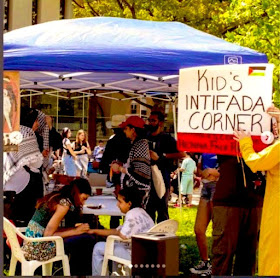While the headline says, "Intense Security at Peaceful Parade for Israel in Manhattan," within the article it says, "The event was mostly peaceful and drew very few protesters."
"Mostly peaceful"? That phrase has become a euphemism to minimize the violence, intimidation and incitement seen at the thousands of anti-Israel demonstrations worldwide since October 7.
Yet there is a world of difference between anti-Israel and pro-Israel demonstrations. Even yesterday's rally attracted anti-Israel protesters with violent messages that the NYT doesn't want to cover, but the New York Post did, showing this protester with a "Kill Hostages Now" sign.
The Times minimized the peacefulness of the pro-Israel protest and ignored the hate from the anti-Israel demonstrators.
This is par for the course for the media.
The Black Lives Matters demonstrations in 2020 that often devolved into looting and burning areas of cities were also described as "mostly peaceful" by the media, a characterization that was much derided. Yet we see the same misleading language being used in anti-Israel demonstrations.
Not to say it is strictly inaccurate. Most demonstrators are not violent, and most demonstrations are people marching without causing damage. But the word "mostly peaceful " is a meaningless term. By the expansive definition of "mostly peaceful" in the media, they could accurately say that war is "mostly peaceful" as well, since the amount of time soldiers are actually shooting is only a small percentage of their day.
You hardly ever see the phrase "mostly peaceful" to describe right-leaning demonstrations. It is not a description - it is propaganda that indicates the the bias of the reporters and editors.
When the NYT uses the same phrase to describe pro-Israel and anti-Israel rallies, it is equating the two. And there is no equivalence.
The pro-Israel rally in New York, as with virtually all pro-Israel rallies, was entirely peaceful, not "mostly peaceful"
Compare two London demonstrations this past week, The massive rally to bring the hostages home on Sunday, with 40,000 participants, went off without any incident. Four days earlier, however, an anti-Israel rally in London was described by the BBC this way:
Three police officers have been injured during a demonstration in Westminster organised by the Palestine Solidarity Campaign and other groups.One officer suffered a serious facial injury after she was hit with a bottle thrown from within the crowd, the Metropolitan Police said.40 arrests related to assaults on emergency workers, obstruction of the highway and public order act breaches were made, the force said.Police said the "vast majority" of protesters - between 8,000 and 10,000 people - left without incident at the scheduled time.A group of about 500 remained and continued to protest.
See? It was mostly peaceful, too!
There is no comparison. The anti-Israel rallies, usually falsely described as "pro-Palestinian," include vandalism, intimidation, blocking access, antisemitism and property damage. A study that claimed that 97% of the college demonstrations have been "peaceful" considered spray paint vandalism as peaceful as well, yet that vandalism has cost universities millions of dollars.millions of dollars.
It is also illegal.
But beyond that is the difference in messages. People chanting to "globalize the intifada" or "resistance by any means necessary" are inciting violence against Jews. Characterizing their demonstrations as "mostly peaceful" is beyond dishonest - they are glorifying violence.
No one can say that the "Kids' Intifada Corner" at the University of Waterloo last week was violent - but it was most certainly the most horrific kind of incitement, teaching innocent children that killing Israelis is legitimate resistance, and fun, too.
An April op-ed in the NYT by a reporter covering the protests showed the bias clearly. She admitted that there were some big problems with the anti-Israel demonstrations, but then justified them: "While reporting on the protests up close gave me insight into how unsettling some aspects of activism can be, it doesn’t mean the protesters’ actions are misguided. These young people seek a worthy cause: to end what may be the most brutal military operation for civilians in the 21st century."
Here we have the problem with left-leaning journalists in a single sentence. The violence and antisemitism in the protests are swept under the rug; it is praised as being worth it for a good cause, a righteous war in Gaza meant to destroy Hamas and minimize civilian casualties despite Hamas' human shield strategy is framed as being unmitigatingly evil, and a it spreads an absurd libel about this being the most brutal war for civilians this century, ignoring Syria, Iraq, Afghanistan, Yemen and Congo, which the students were silent about.
That is the problem with "mostly peaceful." The phraseis meant to justify anti-Israel and antisemitic incitement, and even to praise it. And using it to describe a completely peaceful event on the other side means to equate the two sides, when there is no equivalence - they are polar opposites.





